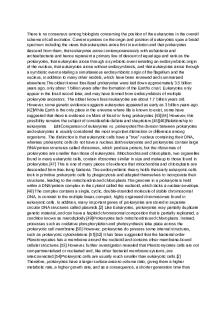5. Conduct - Lecture notes 5 PDF

| Title | 5. Conduct - Lecture notes 5 |
|---|---|
| Course | Health Psychology |
| Institution | University of Hertfordshire |
| Pages | 4 |
| File Size | 63.4 KB |
| File Type | |
| Total Downloads | 78 |
| Total Views | 181 |
Summary
5. Conduct...
Description
5. Conduct disorders What? Persistent pattern of anti-social behaviour that violates societal norms Can fall into 4 categories 1. Aggression to people and animals 2. Destruction of property 3. Deceitfulness and theft 4. Serious violation of rules DSM distinguishes between adolescent and childhood types ODD and conduct Distinct or precursor= oppositional defiant disorder ODD is diagnosed if children do not meet the criteria for CD Relates to losing temper and annoying others ODD Is comorb with ADHD 3/4x more likely in boys than girls DSM- organizes three disorders hierarchally Prevalence Fairly common 9.5% Gender Four times as likely in boys, narrows in adolescence with more girls being diagnosed Underestimation of CD in girls Girls may be better at concealing CD, more strategic Intelligence Children have low IQ levels May be less resistant to encouragement Social cognition Hostile attribution bias- engage in aggression with those they believe are hostile Personality Defined by impulsivity, self esteem and unemotional interpersonal style Peer issues 1) often rejected by their peers during school years 2) associate with other similar peers Typologies Childhood Vs adolescent Callous-unemotional traits/psychopathy
Destructive/ non destructive Over/covert Proactive vs. reactive Child onset Begins prior to 10 Life course persistent Adolescent onset Normal early development Less severe violence Proactive and reactive Reactive more likely to come from abusive families to be irritable and perceive others as more hostile Developmental pathways Early childhood- ADHD to CD Middle childhood-ODD to CD Adolescence- divergent pathways Etiology Biological Context Temperament Difficult temperament predisposes children to impulsivity, irritability and over activity (Frick & Morris, 2004) • Genetics 50% can be accounted for by genetics and a further 11% shared environment (Rhee & Waldman, 2002). Specific gene MA0-A is implicated (Lahey, 2008) Exposure to toxins (opiates in utero) increased aggression behaviour at 10 years (Lahey, 2008). Individual Context Self-regulation Early socialization of self control is lacking Emotion regulation Difficultly managing strong negative emotions (Eisenberg et al., 2010) Prosociality, moral development, empathy Less cognitive mature in their moral reasoning (Barriga et al., 2009); Less empathic (Sterzer et al., 2007) Social cognition Hostile attribution bias (Dodge and Pettit, 2003) Substance abuse Four out five youths currently in the US Juvenile justice system had a prior history of substance offences Family Context Attachment Linked to insecure attachment.
125 youth evidenced anxious attachment style and increased rates of delinquency (Allen et al, 2002). Parent psychopathology Maternal Depression (Crockenberg et al., 2008; Maternal anxiety (Meadows et al., 2007). Most poweful predictor is parent antisocial personality disorder (Lahey et al., 2005). Parenting style Harsh parenting and the intergenerational transmission of aggression. Parenting inconsistency and lack of monitoring.
Family context Coercion theory-Parents of CD more likely to positively reinforce aggressive behavior (Reid et al., 2002). Transactional process (parents and child affect and shape each other’s behavior) Dynamic systems theory (Granic & Patterson, 2006) Developmental perspective on parenting Parental responsiveness Parental insistence Parental inconsistency Family processes Children more likely to be exposed to interparental conflict and violence are more likely to develop conduct problems (Kouros et al., 2010) Family stress increases chances of CD Social Context Negative reputation Aggressive children gain a negative reputation Peer rejection Leads further to aggressive behavior (Dishion & Patterson, 2006). Antisocial peer groups Accepted in to groups that tolerate of even value problem behaviour Early sexual maturation Increases risk for both genders (Negriff & Susman, 2011) “Pushing” versus “pulling” 38 Cultural Context • The neighbourhood Poverty ,social disorganization and community violence (Lynch, 2003 School environment High degrees of fighting, vandalism, defiant students and teachers unable to maintain order (Kasen et al., 2004) Media influences Violent hero’s with few negative consequences (Eron, 2001) Intervention Cognitive behaviour intervention
Parent management Systematic family treatment Multisystematic therapy...
Similar Free PDFs

5. Conduct - Lecture notes 5
- 4 Pages

5 - Lecture notes 5
- 4 Pages

Lesson 5 - Lecture notes 5
- 22 Pages

5 Statehood - Lecture notes 5
- 4 Pages

Prokaryotes 5 - Lecture notes 5
- 2 Pages

Chapter 5 - Lecture notes 5
- 15 Pages

Chapter-5 - Lecture notes 5
- 6 Pages

Chapter 5 - Lecture notes 5
- 83 Pages

Tutorial 5 - Lecture notes 5
- 3 Pages

Chapter 5 - Lecture notes 5
- 4 Pages

Imagen 5 - Lecture notes 5
- 1 Pages

Quiz 5 - Lecture notes 5
- 11 Pages

Chapter 5 - Lecture notes 5
- 20 Pages

Chapter 5 - Lecture notes 5
- 4 Pages

5. Emotions - Lecture notes 5
- 8 Pages

Tema 5 - Lecture notes 5
- 10 Pages
Popular Institutions
- Tinajero National High School - Annex
- Politeknik Caltex Riau
- Yokohama City University
- SGT University
- University of Al-Qadisiyah
- Divine Word College of Vigan
- Techniek College Rotterdam
- Universidade de Santiago
- Universiti Teknologi MARA Cawangan Johor Kampus Pasir Gudang
- Poltekkes Kemenkes Yogyakarta
- Baguio City National High School
- Colegio san marcos
- preparatoria uno
- Centro de Bachillerato Tecnológico Industrial y de Servicios No. 107
- Dalian Maritime University
- Quang Trung Secondary School
- Colegio Tecnológico en Informática
- Corporación Regional de Educación Superior
- Grupo CEDVA
- Dar Al Uloom University
- Centro de Estudios Preuniversitarios de la Universidad Nacional de Ingeniería
- 上智大学
- Aakash International School, Nuna Majara
- San Felipe Neri Catholic School
- Kang Chiao International School - New Taipei City
- Misamis Occidental National High School
- Institución Educativa Escuela Normal Juan Ladrilleros
- Kolehiyo ng Pantukan
- Batanes State College
- Instituto Continental
- Sekolah Menengah Kejuruan Kesehatan Kaltara (Tarakan)
- Colegio de La Inmaculada Concepcion - Cebu